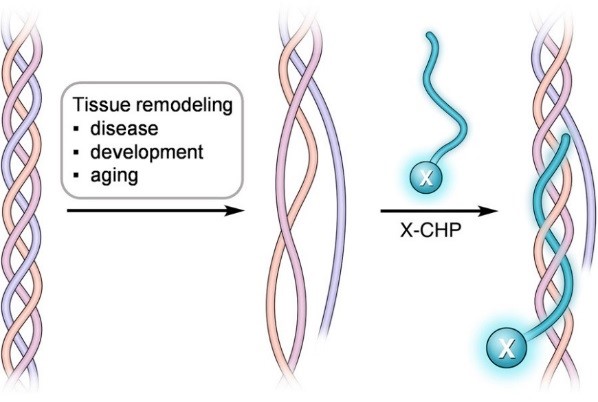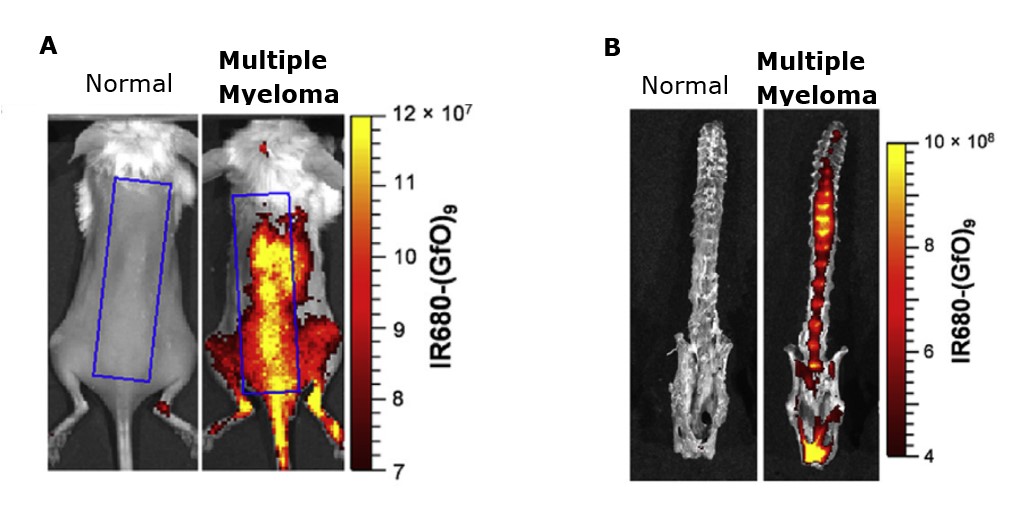Collagen Hybridizing Peptides (CHP) In Vivo Probe
The CHP In Vivo Probe can be used for systemic or in situ injection, which allows visualization of degraded collagen in small living animals.
The CHP In Vivo Probe is a powerful in vivo tool, which enables straightforward detection of inflammation and tissue damage caused by a large variety of diseases, as well as tissue remodeling during development and aging1. With the help of CHP mechanical injury to collagenous tissue can be measured and localized at the molecular level2.
The CHPs are labeled with sulfonated-cyanine 7.5 dye for near-infrared fluorescence (NIRF) detection. This wavelength offers better tissue penetration while minimizing tissue autofluorescence.

By sharing the structural and sequence motif of natural collagen, CHP has a strong capability to hybridize with denatured collagen strands, in a fashion that is similar to a DNA fragment annealing to its complimentary DNA strand during PCR3,4.
Key benefits
- High affinity and unparalleled specificity to collagen with essentially no nonspecific binding
- Applicable to all types of collagen from all species, relying on collagen’s secondary structure instead of any defined sequence for binding
Features
- Small size (2% of IgG by MW) enabling facile tissue penetration and whole specimen staining without sectioning
- Stable in solution at 4 °C, eliminating the need to aliquot for storage
Applications
- In vivo imaging of small animals

In vivo imaging of bone destruction in a mouse model of multiple myeloma (MM). A) N-terminal near-infrared fluorescence (NIRF) images of the normal control mouse and the MM mouse, acquired 3 hours after intravenous injection with CHP In Vivo Probe, demonstrating elevated CHP signal around the spine region from the MM mouse. B) NIRF images of the spine harvested from the mouse. Images obtained from Bennink et al.3.
Available products
CHP In Vivo Probe is available for imaging in small animals with a sulfo-cyanine-7.5 label.
| Item | Description | Regulatory status | Package size | Product code |
| Target-sCy7.5-CHP1 | CHP In Vivo Probe Targeted conjugated with sulfo-cyanine-7.5 | [RUO] | 3 doses | INVIVOTGT7.5 |
| Control-sCy7.5-scCHP1 | CHP In Vivo Probe Control conjugated with sulfo-cyanine-7.5 | [RUO] | 3 doses | INVIVOCTL7.5 |
| sCy7.5 In Vivo Kit1 | CHP In Vivo kit conjugated with sulfo-cyanine-7.5 | [RUO] | 10 doses Targeted, 3 doses Control | INVIVOKIT7.5 |
| 1 Distributed for 3Helix Inc., Salt Lake City, USA | ||||
Order now!
Order your products via our order form!
Product codes: INVIVOTGT7.5, INVIVOCTL7.5, INVIVOKIT7.5
Introduction
Collagen is the most abundant protein in mammals. It is the major structural component of almost all organs and tissues. Excessive collagen degradation is implicated in a variety of pathological conditions, such as cancer, arthritis and fibrosis3.
The triple helix is the hallmark structure of collagen. During tissue remodeling, the triple helical collagen molecules are degraded by specific proteases (e.g. MMP or cathepsin K) and become unfolded at body temperature. The Collagen Hybridizing Peptide (CHP) is a synthetic peptide that can specifically bind to such denatured collagen strands through hydrogen bonding in histology4, in vivo4, and in vitro (3D cell culture)3. CHP is an extremely specific probe for unfolded collagen: it has negligible affinity to intact collagen molecules due to the lack of binding sites; it is also inert towards non-specific binding because of its neutral and hydrophilic nature5.
- Visualizing collagen proteolysis by peptide hybridization: From 3D cell culture to in vivo imaging. Biomaterials, 2018, 183, 67–76. https://www.sciencedirect.com/science/article/pii/S0142961218305933
- Molecular level detection and localization of mechanical damage in collagen enabled by collagen hybridizing peptides. Nature Communications, 2017, 8, 14913, doi: 10.1038/ncomms14913. https://www.nature.com/articles/ncomms14913
- Targeting and mimicking collagens via triple helical peptide assemblies. Current Opinion in Chemical Biology, 2013, 17, 968– 975. https://www.ncbi.nlm.nih.gov/pubmed/24210894
- Targeting collagen strands by photo-triggered triple-helix hybridization. Proceedings of the National Academy of Sciences of the United States of America, 2012, 109, 14767–14772. https://www.ncbi.nlm.nih.gov/pmc/articles/PMC3443117/
- Direct detection of collagenous proteins by fluorescently labeled collagen mimetic peptides. Bioconjugate Chemistry, 2013, 24, 9–16. https://pubs.acs.org/doi/abs/10.1021/bc3005842?journalCode=bcches